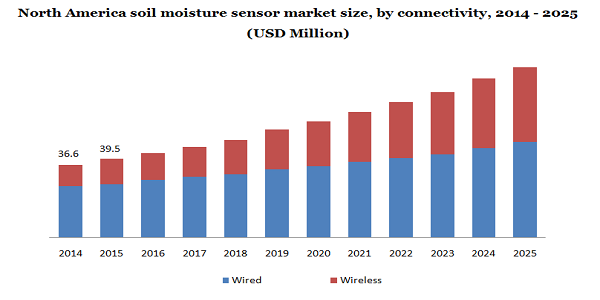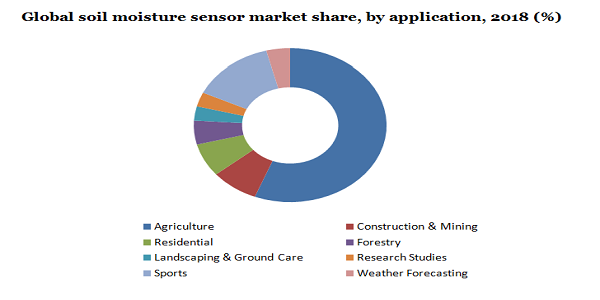- US: +1-408-610-2300
- Toll Free: +1-866-831-4085
- Become a Client
The global soil moisture sensor market size was accounted for USD 173.6 million in the year 2018 and is estimated to register a CAGR of 14.0% over the forecast period, 2019 to 2025. Increasing the use of these sensors across the agricultural sector to strengthen the farm’s productivity and lower water consumption is likely to augment market growth from 2019 to 2025. Furthermore, this product helps in preventing irrigation problems through continuous monitoring, which is supplementing the market growth. The launch of latest technologies that help residential owners to track soil moisture conditions of vegetable gardens, lawns, and potted plants are further anticipated to propel the market.

The demand for low-priced sensors like granular matrix and tensiometers, mainly in the residential sector for sustaining lawns, is stimulating market growth. These devices held a revenue share exceeding 45% in 2018. The adoption of soil moisture sensors among the weather forecasters to provide precise weather readings and prospects is also an important factor boosting the market. The division is likely to witness substantial growth by 2025.
The rising need for soil moisture sensors in the construction and building sector is further expected to foster the market growth shortly. This product is largely preferred before the onset of a construction project for wetland identification. The increasing need for the measurement of the volume of water at the construction sites is propelling market growth. On the other side, unawareness among farmers about the advantages of sensors, inclination towards conventional farming practices, and lack of skilled labor, mainly in developing countries, are posing challenges to the overall growth of the soil moisture sensors market.
North America accounted for the largest share in 2018 due to the subsequently higher use of mechanized farm activities and increased R&D in the area of wireless sensor technology. Moreover, the farmers in this region are relatively more aware of the advantages of soil moisture sensors. Additionally, the farmers are gaining huge support to use mechanized farming practices from associations like The Nature Conservancy, the National Research Council, and the Environmental Protection Agency (EPA).
Soil water potential sensors held the largest segment in 2018 with a share of over 65.0%. These sensors are easy to use, require minimal maintenance, low cost, and offer precise measurement. Tensiometers help to measure tension between water molecules and soil particles and thereby, accounted for the highest share in 2018.
Volumetric soil moisture sensors are anticipated to register considerable growth from 2014 to 2025 due to the precise and timely data available to farmers and minimal calibration required during installation. Probes, time-domain transmissometry (TDT), and capacitance sensors are various other segments available. The TDT sensors are likely to exhibit substantial CAGR in the upcoming years. They consume less power, are durable, and efficiently control the impact of noise to get accuracy. These advantages have fueled demand for these sensors over the years.
Wired sensors held the largest market in 2018 with a share of above 65.0% based on revenue. Issues relating to the product include labor cost, inflexibility, and maintenance cost in terms of remote accessibility. They are suitable for experiments in sectors like agricultural science, biology, environmental science, and botany.
The wireless segment is expected to register the highest growth by 2025. They are extensively adopted to calculate volumetric water content in the soil. For instance, the partnership between Kerlink, a French company, and Sensoterra (Netherlands) to aid farmers make data-controlled land management choices and substantially lower the water consumption up to 30%. With Kerlink’s Low Power Wide Area Network-enabled IoT space, Sensoterra is anticipated to introduce the latest wireless soil moisture sensors in Europe, Asia Pacific, and North America.
The agriculture application segment held the leading market with a share of above 55.0% in 2018. The growing use of sensors in agricultural fields has allowed farmers to lower water consumption and increase total food production. The aforementioned advantages are predicted to boost segment growth over the forecast period. Additionally, rising government attention for water conservation for producing better quality crops is stimulating the market.

To maintain and ensure a lush outfield, the sports segment has observed substantial growth. For instance, the sensors are largely adopted for maintaining golf turfs. Further, investments by the government for improving the sports fields and the demand for controlled growth of grass on sports grounds is primarily responsible for the growth of this segment.
North America held the leading market in 2018 due to the higher use of sensors across the sports and agriculture segments. The U.S. is home to numerous soil moisture sensor manufacturers like The Toro Company and Campbell Scientific, Inc. Strict environmental norms and increasing use of accurate farming and yield tracking activities by small and large farm owners to enhance their field’s productivity is likely to propel the market growth.
Asia Pacific is likely to grow at a higher CAGR from 2019 to 2025 due to the rising awareness about the use of these sensors among farmers. Additionally, the presence of high arable land in nations like India and China is anticipated to surge the use of soil moisture sensors. Moreover, the increasing concern for soil health in this region is favorable for market growth. Countries like India, China, Australia, and Japan are anticipated to generate subsequent revenue due to the positive government initiative and increasing disposable income of farmers.
Key players in the market are aiming to enhance their product portfolio to strengthen their market position. For example, The Toro Company, in August 2017, announced to introduce wireless sensor technology, i.e. ‘Turf Guard Soil Monitoring System’. This new technology is equipped with a superior wireless mesh network technology that tracks the moisture level, salinity level, and soil temperature.
The Toro Company further announced to introduce the Toro Precision soil sensor to enhance applications in the residential sector. This sensor constantly monitors soil moisture. Some of the key players in the soil moisture sensor market include Campbell Scientific Inc. (U.S.), Sentek (Australia), Spiio (U.S.), Irrometer Company, Inc. (U.S.), METER Group, Inc. USA (U.S.), Acclima Inc. (U.S.), Spectrum Technologies, Inc. (U.S.), IMKO Micromodultechnik GmbH (Germany), Toro Company (U.S.), and E.S.I. Environmental Sensors Inc. (Canada).
|
Attribute |
Details |
|
The base year for estimation |
2018 |
|
Actual estimates/Historical data |
2014- 2017 |
|
Forecast period |
2019- 2025 |
|
Quantitative units |
Revenue in USD million & CAGR from 2019 to 2025 |
|
Report coverage |
Revenue forecast, company share, competitive landscape, and growth factors and trends |
|
Segments covered |
Sensors, connectivity, application, region |
|
Regional scope |
North America, Europe, Asia Pacific, South America, and Middle East & Africa |
|
Country Scope |
U.S., Canada, Mexico, UK, Germany, France, China, Japan, Australia, Brazil |
|
Key companies profiled |
Toro Company (U.S.); Campbell Scientific Inc. (U.S.); Spiio (U.S.); Sentek (Australia); METER Group, Inc. USA (U.S.); Irrometer Company, Inc. (U.S.); Acclima Inc. (U.S.); IMKO Micromodultechnik GmbH (Germany); Spectrum Technologies, Inc. (U.S.); E.S.I. Environmental Sensors Inc. (Canada) |
|
Customization Scope |
Free report customization (equivalent to up to 8 analysts’ working days) with purchase. Addition or alteration to country, regional & segment scope. |
|
Pricing and purchase options |
Avail of customized purchase options to meet your exact research needs. |
This report forecasts revenue growth at global, regional, and country levels and provides an analysis of the latest industry trends in each of the sub-segments from 2014 to 2025. For this study, Million Insights has segmented the global soil moisture sensor market report based on sensors, connectivity, application, and region:
• Sensors Outlook (Revenue, USD Million, 2014 - 2025)
• Volumetric Soil Moisture Sensors
• Capacitance
• Probes
• Time Domain Transmissometry (TDT)
• Soil Water Potential Sensors
• Gypsum Blocks
• Tensiometers
• Granular Matrix
• Connectivity Outlook (Revenue, USD Million, 2014 - 2025)
• Wired
• Wireless
• Application Outlook (Revenue, USD Million, 2014 - 2025)
• Agriculture
• Construction and Mining
• Residential
• Forestry
• Landscaping and Ground Care
• Research Studies
• Sports
• Weather Forecasting Residential
• Regional Outlook (Revenue, USD Million, 2014 - 2025)
• North America
• U.S.
• Canada
• Mexico
• Europe
• Germany
• U.K.
• France
• The Asia Pacific
• China
• Japan
• Australia
• South America
• Brazil
• Middle East & Africa


Research Support Specialist, USA